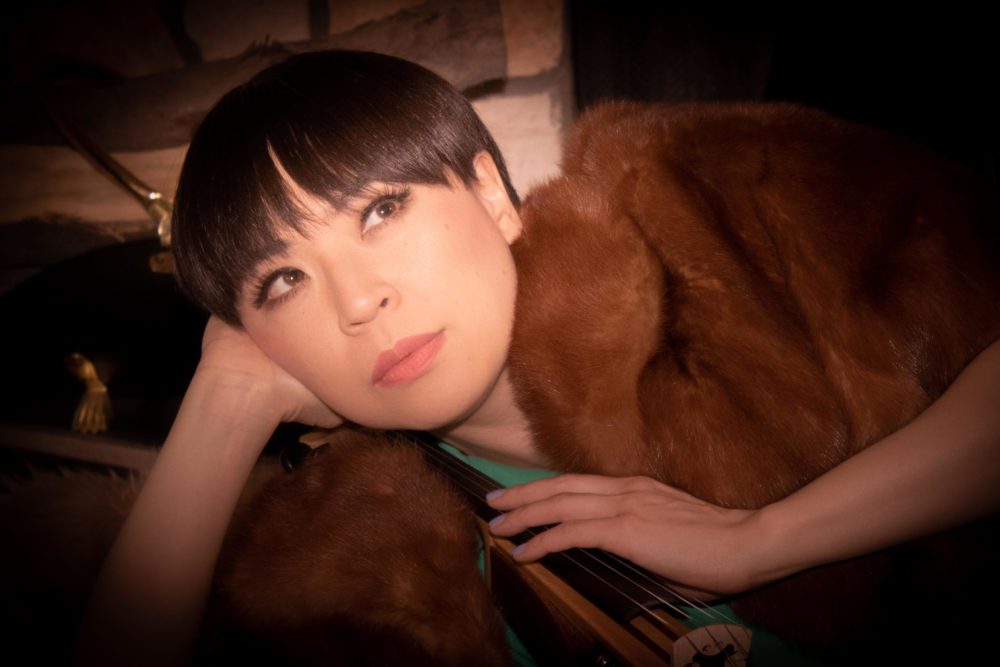

The state of the world can be discouraging for those working toward gender equality, but Calgary, Canada-based singer-songwriter/multi-instrumentalist Clea Anaïs reminds us not to give up, even amid all the setbacks, with her latest single “Powerful Women.” Against snappy drums and synths, her airy voice sings words of encouragement: “If the fuel of that fire ignites/As you stand in its flames/Know I see you/It’s the brave who remain in that light/If the battle lasts long/Know I feel you/We come from a line of powerful women.”
For the video, Anaïs worked with dancer Pam Tzeng to create flowy, emotive choreography and incorporated footage of women from diverse backgrounds and occupations throughout history, using a purple color palette, floral imagery, and a kaleidoscope effect to create beautiful symmetry.
Most of the footage was either donated or found in a collection of films from the Prelinger Archives, which showcases U.S. cultural history. Anaïs had to incorporate some present-day footage in order to showcase a diverse group of people. “As a person of mixed background, something that was notable to me was the type of footage that existed in these archives and how limited it was in terms of ever seeing women of color,” she explains.
“We really focused on trying to find clips of women who were experiencing joy or working on things that they loved,” she adds. “There’s something kind of global about he track itself, and that really brought in the idea of having all these women be a part of this imagery because it’s driven by the universality.”
“Powerful Women” was born from a conversation Anaïs had with her niece and sister about the the decision to swear in Brett Kavanaugh as Supreme Court justice despite the sexual assault allegations against him. She remembers her niece being disappointed by this outcome, and she wanted to write a song with a message of hope for her and other young women.
She describes the song as “a reminder and a call to action for people to continue to fight for what they believe in even if they don’t necessarily see immediate results,” she says. “I wanted to write this song to remind [my niece] not everything has a negative ending, and even if things do have a negative outcome, it’s still worth showing up.”
Alongside its theme of empowerment for women, she hopes the single speaks to all people about the “deep strength that comes before all of us as humans” and how everyone can tap into it. “A lot of what is out there to consume can be very heavy, and a lot of art at this point in time is very reflective on things that have not been great throughout the course of human history,” she says. “A lot of my work is about wanting to give some light in these crazy times.”
Anaïs started off her musical career playing in bands, most recently the Canadian experimental indie-rock band Raleigh; in addition to music, she worked as a flight attendant and recently trained as a commercial airline pilot. When COVID sidelined commercial flights, she took the opportunity to work on solo music she’d been sitting on. During a residency at Alberta’s esteemed Banff Centre for Arts and Creativity, she practiced using music production program Ableton and producing her own songs.
“Powerful Women” was one of the first tracks she wrote on Ableton, then she brought it to an engineer and some other musicians to rework it. She incorporated some unusual instruments such as the tiple, charango, and mellotron along with her usual guitar and vocals and worked with engineer Will MacLellan to add effects like layering.
She also recently released her debut solo single “Hazy Days,” a moody, percussion-driven track about “that feeling when you meet somebody and you’ve fallen in love without having to say anything — you just connect with a person,” she explains. “It’s also a song about impermanence — how life moves forward and you just have to enjoy the moments that are special.”
These two tracks signal the arrival of an upcoming full-length album Anaïs is working on, which centers on themes of self-reflection, resilience, and gratitude. She worked with Tzeng to create a dance piece for each song that will go in the accompanying collage-style videos. Though she wrote many of the songs during a dark time in her life and the lyrics reflect that, she used the production to give the music an upbeat, optimistic vibe. “I wanted it to have momentum, and I wanted it to move people,” she says. “Even the darker stuff, the minor stuff, I wanted it to have some kind of propulsion.”
Sonically, her goal is more to portray an emotion than to project a particular style, and that’s evident in her genre-defying works. “I’m not very good, I suppose, at being like ‘I want to be like this band’ and then working to create that sound,” she says. “That’s never my approach to what I do, which is not necessarily good because then you don’t get to fit into a genre as easily. But for me, it’s so much more about inviting the listener into an experience or a feeling than having a particular sound at the end of the day.”
Follow Clea Anaïs on Instagram and Facebook for ongoing updates.


